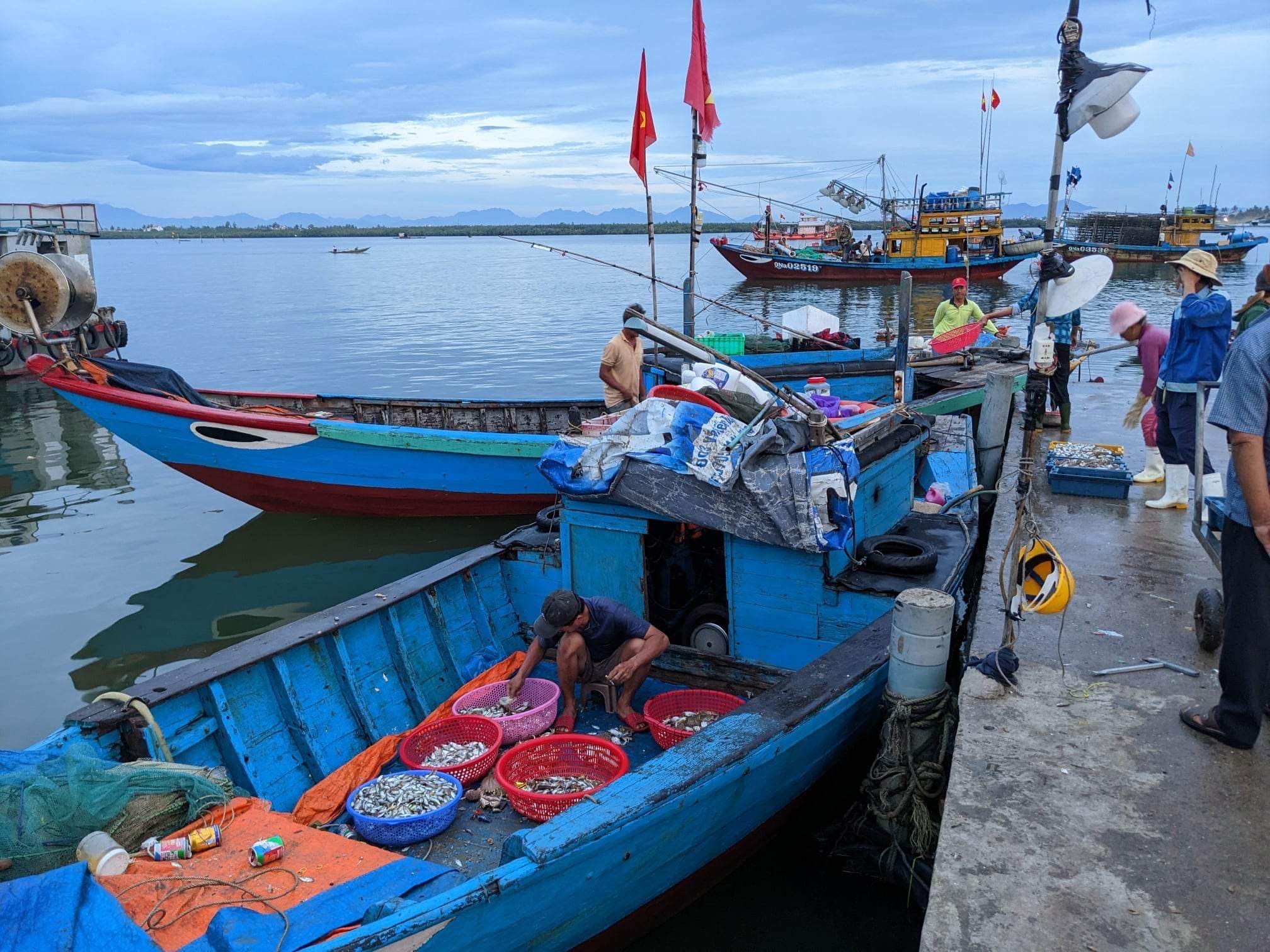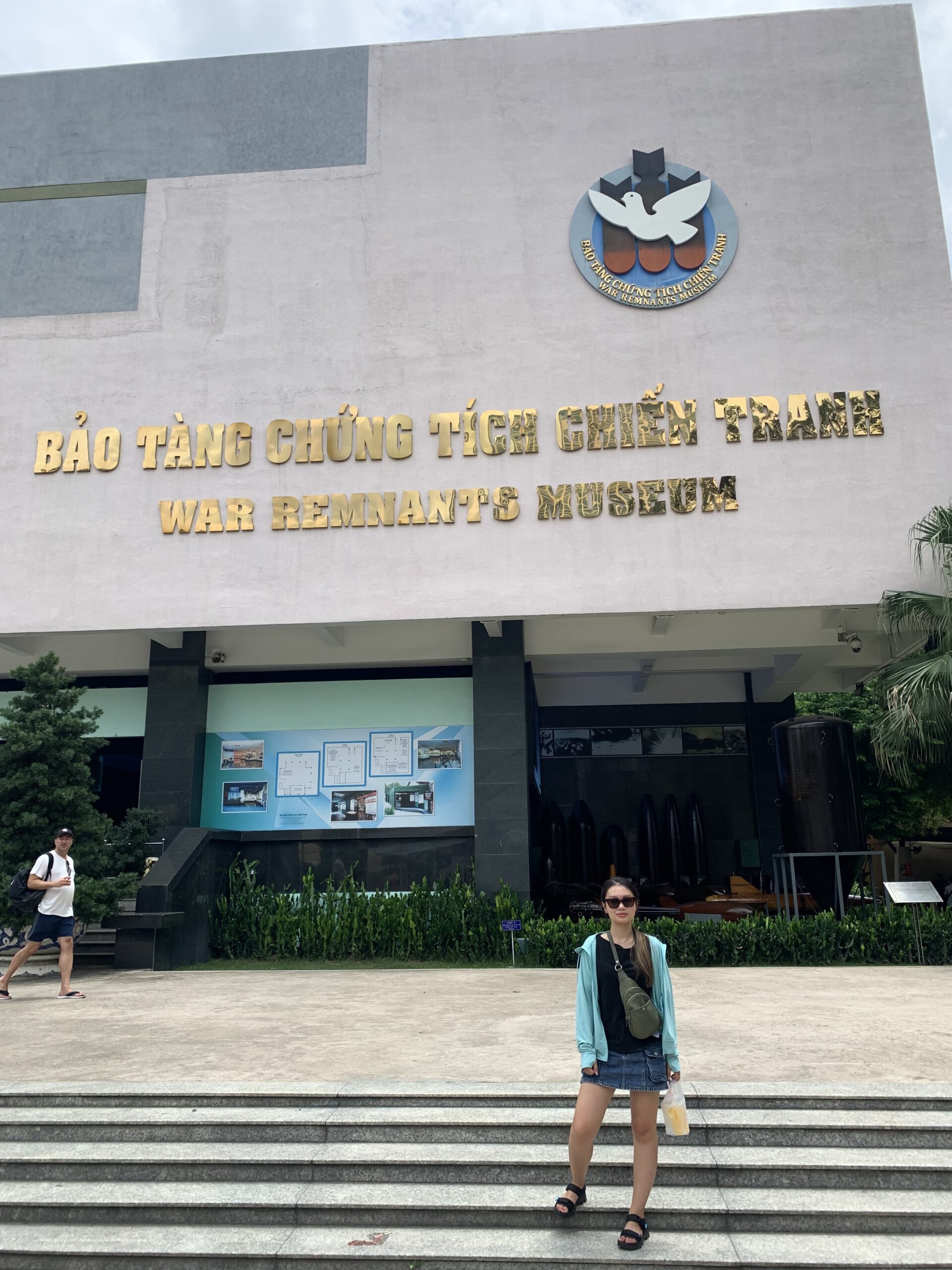Local Fishing Villages and the Troubled Future of Fishing in Việt Nam
The sun had not even risen when my tour guide rolled up to the hotel entrance in a war-era U.S. military jeep, a camouflaged monster roaring with noxious fumes to crack the silence of Hội An city’s early morning. After brief introductions in the faint gleam of the jeep’s headlights, I joined the guide and his driver on a bumpy and adventurous ride to the fishing village at the edge of town, feeling strangely ironic as a Vietnamese American passenger in an American military jeep. Never mind that I spoke Vietnamese—I was the only person who booked the tour that day, and riding along in the jeep certainly made me stand out like a deer in the headlights. I could’ve just screamed, I’m an American tourist! to anyone who cared to listen.
When we arrived half an hour later at the fishing village, I did not expect what I saw. There were hundreds of colorful boats docked on the harbor, offloading plastic buckets of fish in all sizes, shapes, and colors. Surrounding the docks were mostly women sitting on little stools, selling the fresh catch to local customers, who were just ambling in from nearby towns for their morning groceries. “We are already late,” my guide said, “because many of the boats came with their fish around 4 a.m. It is already almost 6 a.m.” I couldn’t imagine the space being any more hectic than it was already. People were shoving past me left and right, haggling for lower prices on their sardines and anchovies. An older woman in a conical hat called out, “Young lady, buy some stingray to start my sales today!” My tour guide trailed ahead, and I followed him, declining the stingray.

My name is Ann Ngoc Tran, and I am a Ph.D. Candidate in the Department of American Studies & Ethnicity, working under the direction of Dr. Viet Thanh Nguyen. The motivation behind my peculiar jeep ride to the fishing village in Hội An, a small city in Quang Nam province a mere thirty minutes from Đà Nẵng, was to explore central Vietnamese fishing customs and traditions that have been embedded in the local culture for the past century. My research seeks to understand how these practices have been fundamental not just to Vietnamese social life, but also vital to survival during war, migration, and (re)settlement in the United States, where many refugees returned to their former occupations as fisherpeople and shrimpers in the Gulf South in the 1980s and 1990s.
On the coasts of Texas, Louisiana, Alabama, Mississippi, and Florida, thousands of Vietnamese and other Southeast Asian refugees revived their trade in the waters of the Gulf of Mexico, engaging in fellowship with each other and violent altercations with white fishermen who resented their “invasion.” Coming from Texas myself, I knew of these stories even as they have only recently become more mainstream—how white locals and the KKK burned Vietnamese-owned boats to valiantly tout their white supremacy, then rallying for the eviction of “Viet Cong” from their turf after a deadly gunfight broke out in Seadrift, Texas between a white fisherman and a Vietnamese refugee. My project began with an interest in these fisher folx’s stories and their previous lives, which has led me to various towns on the Gulf Coast, and eventually to Việt Nam.
I came to Việt Nam partly to trace the histories of native fishing villages and Vietnamese folk knowledge about boat-making, fishing, shrimping, and other uses of both fresh- and saltwater. Water is an important part of life for the Vietnamese people, who depend on the fertile river deltas for their rice production and the coasts for their staple fish sauce and seafood supply. Mostly men work on the boats, while women sell the catch. There are several different types of vessels that are used for fishing—the thúng tre (circular bamboo boat used mostly for shallow-water fishing or squid-fishing), the thuyền (a flat-bottomed wooden sampan, often used for shallow-water river fishing or for selling merchandise), and the tàu đánh cá (the larger, more equipped boats for deep-ocean fishing and shrimping). Most fishing boats in central and southern Việt Nam are still constructed from wood, whereas those in the United States are built from more durable fiberglass. Traditionally, bamboo boats, also called oracles, were made by bending shredded bamboo bark into a rounded shape, secured in place with layers of cow dung to prevent water infiltration. If made properly, the oracles last years and can withstand forceful winds and waves at sea. Fishermen often tote these bamboo boats along on their fishing vessels, dropping them into the water to find squid late at night. For those who go out to the deep ocean for larger catches like barracudas, mackerels, and tuna, a typical journey can take a week or less during the high season, and up to two weeks in the low season.

The fishing industry is a key national economic sector, bringing in over 8 billion dollars in capital for Việt Nam per year, which equates to nearly 4-5 percent of the country’s GDP according to the Vietnam Association of Sea Exporters and Producers. As a result, the Vietnamese government encourages fishermen to stay out at sea by subsidizing engine fuel, which has led to the quadrupling of fishing vessels from 2000 to 2020, concentrated primarily in Central Việt Nam and the Mekong Delta. In recent years, however, the fishing stock in the waters off the coasts of Việt Nam has sharply declined due to overfishing near the shore without providing proper time for marine life to regenerate and the use of destructive fishing methods that include explosives, poison, and uncontrolled net fishing.
Now, many fishermen spend up to a month or longer at sea, some crossing in desperation into the disputed Paracel Islands, which has caused major territorial issues with China and Taiwan. Although the islands were originally under Việt Nam’s authority, China occupied the archipelago in 1974 when its troops seized a South Vietnamese garrison. A politically and ecologically contentious issue, fishing in Việt Nam, particularly in the central regions where the Paracel archipelago is closely situated, has garnered mass media and diplomatic attention.
In fact, there is a museum called Nhà Trưng Bày Hoàng Sa in Đà Nẵng dedicated to honoring the Vietnamese tradition and claim to the islands, citing centuries of seafaring and exploration in the waters of the archipelago. I visited this museum on a sunny afternoon, surprised to find both nationalistic proclamations of Việt Nam’s sovereignty over Hoàng Sa (the Paracel Islands) and a rich history of fishing and seafood production documented in images and archival documents. What to make of these sources? Stay tuned for the dissertation!
I also came to Việt Nam for another history—my late grandfather was a fisherman in Thanh Khê, Đà Nẵng, the first person in his village to own a fishing boat in the early 1950s. He started working as a deckhand when he was a young preteen, saving money slowly until he could afford his own boat in his twenties. He worked in the fishing trade through tumultuous periods in Việt Nam’s history—French colonial rule, American occupation and war, Sino-Vietnamese and Cambodian conflicts—and retired in his seventies. In March 1975, when the American War was close to its end, he boarded the entire Trần family onto his boat, ready to take off for a refugee camp off the coast of Hong Kong. But being the family man that he was, he couldn’t stand to leave his first son, who was still fighting in the south near Saigon, trying to make his way back home. By the time my uncle did, the North Vietnamese army had already entered Đà Nẵng, putting an end to all escapades. If my paternal family had left then, perhaps I would not be here, writing this post today. But if they had, perhaps there’d be a boat somewhere off the coast of Texas, engraved with my grandfather’s name.
Ann Tran is supported by the Diane Sonosky Montgomery and Jerol Sonosky Graduate Fellowship for Environmental Sustainability Research.

